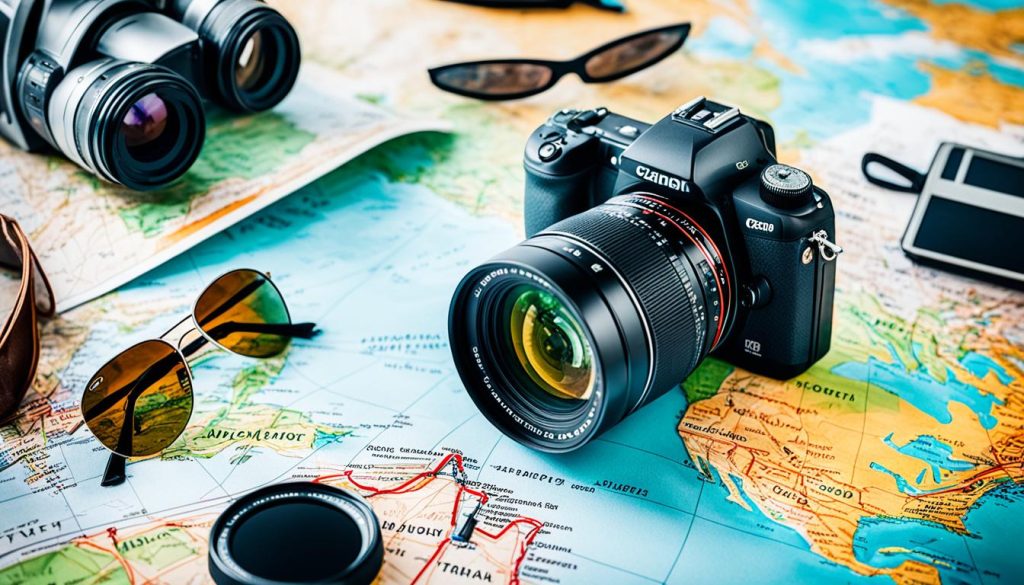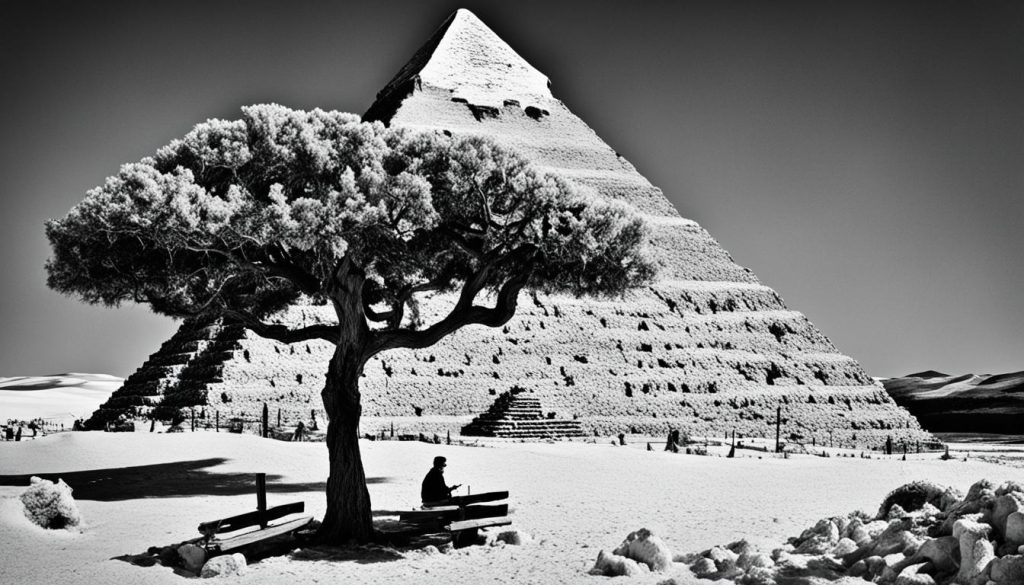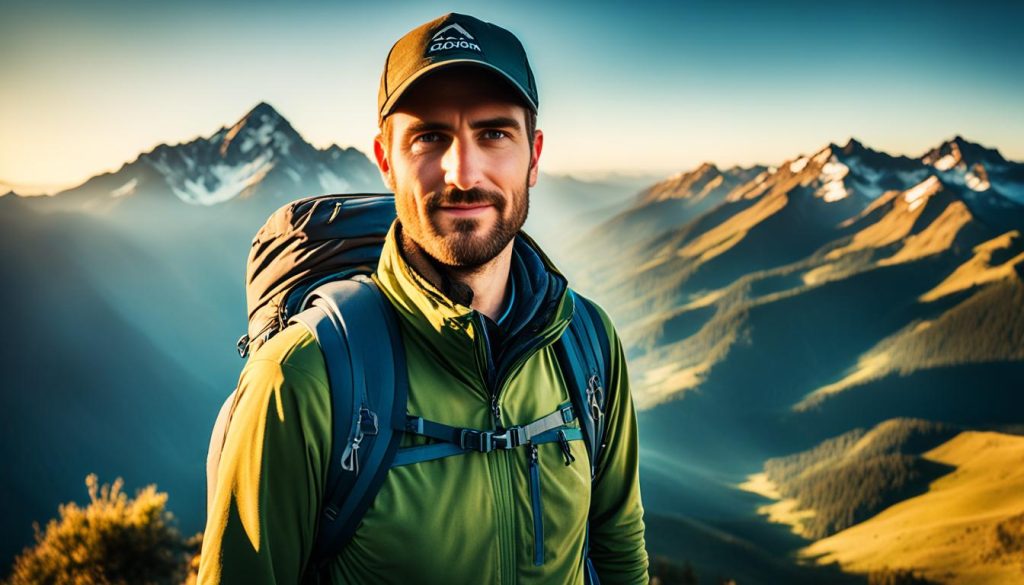“The camera is the save button for the mind’s eye.” – Roger Ebert
Start your adventure into travel photography by learning the basics. Get tips on what gear to use, how to tell stories with your photos. And find out how to take pictures that really capture the moment.
Over time, you’ll become a master at using your camera to tell stories. With some practice, you can create photos that make you feel like you’re back on your trip.
Key Takeaways
- Understand the importance of natural light and the golden hours for captivating travel photography
- Learn essential gear recommendations for on-the-go photographers, including versatile cameras, lenses, and accessories
- Discover techniques to create a compelling visual narrative through a variety of shot types
- Grasp the fundamentals of camera settings and manual mode for better image quality
- Explore post-processing strategies to enhance your travel photos without overdoing it
Travel Photography: Capturing Memories That Last a Lifetime
Travel photography is not just about clicking pictures. It’s a form of art. It lets you freeze the moment of a place and its people forever. You can do this while journeying through a lively city or a calm countryside. The trick to making beautiful travel photos is to tell a story through your pictures.
The Art of Storytelling Through Images
Creating a story with your travel photos begins with knowing your destination. Dive into the local culture. Watch how people live, their daily lives, and what makes the place unique. Once you understand the story you wish to share, your camera can then catch moments. These moments will show the true heart of your experience.
Understanding the Fundamentals of Photography
To take stunning travel photos, you must know the basics of photography. Aperture, shutter speed, and ISO are key camera settings. Play around with these to get the desired result. Also, having the correct camera and lenses is crucial for better photos.
Combine storytelling with photography basics to make unforgettable travel photos. These photos capture not just the scenery but also the feelings and memories that last a lifetime.
“The camera is an instrument that teaches people how to see without a camera.” – Dorothea Lange
To be a great travel photographer, keep an open mind and be ready to try new things. With time and effort, you can refine your craft. You’ll be able to show the world in a way that deeply moves those who see your work.
Mastering the Exposure Triangle
In travel photography, knowing the exposure triangle is vital. It’s the harmony of three key things: aperture, shutter speed, and ISO. This balance is important for getting the right exposure in photos. It helps make your pictures stand out.
Aperture, Shutter Speed, and ISO: The Keys to Perfect Exposure
Aperture, measured in f-stops, controls light by changing the lens opening size. A big aperture (small f-number) lets in more light. A small aperture (large f-number) lets in less light. Shutter speed sets the time the camera is exposed to light. Fast speeds stop motion, while slow speeds show movement. ISO shows how sensitive the camera is to light. High ISOs make photos brighter but can add noise.
Getting the exposure right means balancing these three. Photos are too dark if underexposed and too bright if overexposed. You need the correct mix of these settings to match the light in your scene. This adds the perfect mood to your photos.
- Aperture: Controls light and changes the background sharpness.
- Shutter Speed: Picks how motion looks, whether smooth or frozen.
- ISO: Changes light sensitivity, also affecting photo noise.
To get great travel shots, you must learn to adjust these three settings together. This way, you can finely control your camera and take amazing pictures of your journey.
“Mastering the exposure triangle is like unlocking the door to a whole new world of creative possibilities in photography.”
Remember, the best way to understand the exposure triangle is to try different settings. Experiment, see what works, and learn from each photo. With time and practice, this will lead you to snap photos that truly awe people.
Composition Techniques for Compelling Travel Photos
Taking great travel photos is more than just clicking your camera. It’s about mastering how to compose your shots. By learning photo composition principles, your travel photos will become more than pictures. They’ll be stories that capture your audience.
The rule of thirds is key in photography. It involves splitting your scene into a 3×3 grid and placing items of interest at the grid’s lines or intersections. This technique helps make your photos look balanced and eye-catching. It’s a simple way to enhance the quality of your images.
Use leading lines to direct the viewer’s attention. Leading lines are things like fences, roads, or rivers that draw the viewer’s eye to the main subject. This adds depth and a dynamic feel to your photos. Always look for ways to include these in your photos.
- Use the rule of thirds for a visually pleasing look.
- Add leading lines to draw attention to the main focus.
- Try framing by using natural elements to highlight your subject.
- Play with the symmetry technique to give your photos balance.
“The world is a book, and those who do not travel read only a page.” – Saint Augustine
Remember, while these tips are crucial, they’re not rigid laws. Breaking them might lead to exceptional results. It’s all about discovering your unique style. This comes from experimenting with different methods to see what works best for you and your audience.
With these tips, you’re on your way to taking travel photos that are both engaging and meaningful. Grab your camera, keep these principles in mind, and start capturing your experiences in stunning photos.
Tips for Beginners: Start Your Photography Journey
Starting your travel photography journey is thrilling. You have many chances to capture the world. It’s natural to feel overwhelmed by the technical stuff. But, don’t worry. With the right advice and some trying out, you’ll soon be taking amazing pictures.
For beginners in travel photography, using RAW format is a must. RAW keeps more image info than JPEG. This lets you edit and improve your photos more. It puts you in control, helping you realize your creative ideas.
Trying different camera settings is vital too. Adjusting the aperture, shutter speed, and ISO can lead to unique effects. Playing around and learning what works for you is fun. It’s how you grow as a photographer.
- Embrace the benefits of shooting in RAW format
- Experiment with various camera settings to find your perfect style
- Unleash your creativity and don’t be afraid to try new techniques
“The best camera is the one you have with you.” – Chase Jarvis
Don’t forget, the joy of travel photography is in the journey. Every mishap is a chance to learn. Enjoy the excitement of showing the world through your eyes. These tips will help you become a skilled and self-assured travel photographer.

Landscape Photography: Capturing Nature’s Beauty
Landscape photography is a thrilling part of travel photography. It lets you capture nature’s grand beauty. From stunning vistas to towering peaks and calm woods, you can show how beautiful our world is.
Techniques for Stunning Landscapes
To improve your landscape photos, use some key techniques. A tripod is crucial for clear, steady pictures. This is especially true for long shots or when light is low. A wide-angle lens makes the landscape look huge, pulling the viewer right into the image.
A graduated neutral density (GND) filter is also very useful. It balances light between a bright sky and shadowy land. That way, your pictures won’t lose detail in the sky or the ground.
- Set up your tripod so your camera is firm and won’t move.
- Try a wide-angle lens to show off the vastness of the scene.
- Use a graduated neutral density (GND) filter to fix light differences in the sky and land.
“Landscape photography is the supreme test of the photographer – and often the supreme disappointment.” – Ansel Adams
Learning these techniques will help you take outstanding landscape photos. It’s all about patience, a strong work ethic, and knowing how to frame a great shot.
Lighting Mastery: The Art of Illumination
In travel photography, mastering lighting is crucial. It helps capture stunning images. From the golden hour‘s magical light to backlighting and side lighting‘s effects, knowing light tactics enhances photos.
The golden hour is highly prized in travel photography. It’s the time just before sunset or after sunrise. The warm, golden light makes everything look enchanting. It turns simple scenes into captivating works of art with depth and charm.
Learning about backlighting and side lighting is essential too. Backlighting creates beautiful silhouettes and emphasizes details. Side lighting brings out textures and adds drama with contrasting shadows. These skills make your photos stand out.
Lighting mastery in travel photography means using natural light well. It’s about understanding light and shadow interactions. This helps you enchant viewers with the world’s beauty through your photos.
“Lighting is everything in photography. Without the right light, you will never get the right image.” – Peter Hurley

Exploring and experimenting with lighting is a journey. By trying new approaches and appreciating nature, your photos can tell amazing stories about your travels.
Essential Travel Photography Gear
Being a travel photographer means having the right gear. It makes the difference in getting amazing, unforgettable shots. Cameras, lenses, and key accessories will boost the quality of your photos. This guide will help you choose the essential gear for your travels.
Cameras, Lenses, and Accessories for On-the-Go Photographers
Your camera is the heart of your gear. You might like a DSLR, mirrorless, or compact model. Choose one that matches your photography skill and what you want to achieve. Think about image quality, how easy it is to carry, and what it can do.
In addition to your camera, lenses are key for taking a variety of photos. Pick a zoom lens or a few prime lenses. This gives you the power to shoot broad landscapes, close portraits, and more. Always good to have a choice of wide-angle, standard, and zoom lenses.
- Travel photography gear: Cameras, lenses, and accessories
- DSLR, mirrorless, or compact cameras for on-the-go use
- Versatile zoom lenses and prime lenses for diverse photography
You’ll also need a sturdy tripod for sharp, steady shots and a drone for unique aerial views. And a good camera bag or backpack is essential. It keeps your gear safe and organized while you’re moving around.
- Tripod for steady, sharp shots
- Drone for aerial photography
- Camera bag or backpack to protect and transport your gear
Small but crucial items include extra batteries, SD cards with a high memory, and lens filters. They ensure your photo sessions go well and that you capture every moment perfectly.
“The camera is an instrument that teaches people how to see without a camera.” – Dorothea Lange
Choosing the right gear lets you photograph the world in beautiful and creative ways. Try out different cameras, lenses, and gear to find the best fit for your photography and travel style.
Learning Resources: Online Classes and Beyond
Want to improve your travel photography? There are many ways to learn. Online classes are great for busy people. They help you dive deeper into photography.
Books and magazines are also helpful. They give you new ideas and keep you motivated. You can also join photography groups online. There, you’ll find people to share your work with.
Just starting out or already skilled? There’s something for everyone. Learning and growing are keys in photography. Don’t be afraid to keep trying new things.
Discover all the world of photography education offers. From online classes to blogs and forums, there’s a lot. These resources can really help you get better and be more creative.
FAQ
What is the essence of travel photography?
Travel photography aims to capture the soul of a place and its people. It’s a way to tell a story visually. It makes the viewer feel like they’re living your adventures.
What are the fundamentals of photography I need to understand?
The basics of photography start with research. You need to pack the right gear. Also, you must know how to use your camera’s settings properly. This includes things like aperture, shutter speed, and ISO.
How do I achieve the perfect exposure for my travel photos?
To get the perfect exposure in your photos, you must master the exposure triangle. This triangle involves three key elements: aperture, shutter speed, and ISO. Knowing how to use them together can make your photos stunning.
https://tunekong.com/seasonal-decor-secrets-create-a-cozy-vibe-for-every-time-of-the-year-19/
What are some important composition techniques for travel photography?
Important techniques in travel photography are the rule of thirds and leading lines. They guide the viewer’s eye through your photo. Framing and symmetry can add balance. And don’t be afraid to break these rules for creative results.
What tips do you have for beginners starting their travel photography journey?
Start by shooting in RAW format. This gives you more flexibility during editing. Experiment with your camera settings. And most importantly, enjoy the learning process. It’s key to getting better at photography.
How can I capture stunning landscape photos during my travels?
To capture landscapes, use a tripod for stability. A wide-angle lens helps take in more of the scene. And consider using graduated neutral density filters. These balance light between the sky and the ground.
What are some important lighting techniques for travel photography?
Key lighting techniques include shooting during the golden hour and using backlighting or side lighting. These methods can make your photos more striking and tell a better story.
What essential gear do I need for travel photography?
The must-have gear includes cameras, lenses, and tripods. Also, drones, camera bags, batteries, and lots of SD cards. Pick what suits your style and level best.
What learning resources can help me improve my travel photography skills?
Look into online classes, good books, and magazines. Stay connected with the photography community online through blogs and forums. This will help you learn and get inspired continuously.

